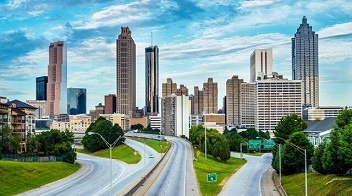 ATLANTA—This week, at the annual Greenbuild conference, the U.S. Green Building Council (USGBC) launched Insight, a new data-driven tool that highlights building project design features that can lead to better performance. USGBC also announced LEED Positive—a vision statement and LEED development roadmap that will lay the foundation for a future of LEED that is regenerative. In addition, USGBC announced that more than 100 cities and communities have now achieved LEED certification. The City of Atlanta, this year’s Greenbuild host city, marked the 100th certification.
ATLANTA—This week, at the annual Greenbuild conference, the U.S. Green Building Council (USGBC) launched Insight, a new data-driven tool that highlights building project design features that can lead to better performance. USGBC also announced LEED Positive—a vision statement and LEED development roadmap that will lay the foundation for a future of LEED that is regenerative. In addition, USGBC announced that more than 100 cities and communities have now achieved LEED certification. The City of Atlanta, this year’s Greenbuild host city, marked the 100th certification.
Insight Announcement
Insight is available as a feature of the Arc platform and provides information on the design attributes of LEED certified buildings within a specified geographic region. Project teams can then compare and rank potential sustainability strategies to see how they stack up against the performance of other buildings. Insight leverages the depth of the existing LEED data to aid designers and builders in adopting smart, practical and achievable sustainability strategies.
“The Insight tool is all about partnership, innovation and green building performance,” said Mahesh Ramanujam, President and CEO, USGBC. “USGBC has a vision of a performance-oriented future and the trajectory of LEED is to continue to improve the performance throughout the lifecycle of buildings. Holistically, LEED enables the best possible buildings—and with tools like Insight, it will also allow building owners and city leaders to better track progress toward their environmental, social and governance (ESG) goals.”
Insight can be leveraged by LEED and green building teams to improve the design—and eventually performance—of their buildings by encouraging the implementation of best practices during the design and construction stage. Insight helps green building and LEED project teams identify practices that could improve building performance and eliminate those that pose a risk to their long-term investment. The new tool is part of USGBC’s continued efforts to leverage data and technology to encourage more informed decisions around sustainability.
Created in Partnership with Skansa
Insight was created in partnership with Skanska—a project development and construction group—and also USGBC member company and longtime supporter of the green building movement. Experts from both organizations worked together over two years to develop the tool.
“Insight can compare your project team’s aspirations for energy, water and waste savings with results from similar buildings in your region, which allows you to visualize how the performance of your project stacks up to other buildings like yours and will help you make informed decisions about practical and achievable sustainability strategies,” said Beth Heider, FAIA, Chief Sustainability Officer, Skanska USA. “Skanska is proud of this work alongside USGBC that provides design phase insight to the Arc platform.”
The ability to consider the impact of strategies and decisions will help building teams be more effective in tracking sustainability performance and progress. Insight supports teams pursuing LEED certification, as well as projects that are already certified, but are committed to maintaining a high level of performance or seeking recertification.
LEED Positive Announcement
LEED Positive is a vision statement and LEED development roadmap that will lay the foundation for a future of LEED that is regenerative.
“We must do all we can to leverage our tools and resources to scale up reductions in carbon emissions associated with buildings, communities and cities,” Ramanujam said. “LEED must evolve qualitatively and quantitatively. Qualitatively, it must transition from strategies that reduce the harm done by buildings to strategies that cause no harm and are regenerative by design, ensuring our buildings are actually giving back more than they take. And quantitatively it will need to accelerate and increase its impact ten to a hundred-fold by leveraging our Arc performance platform. The future of LEED is LEED positive.”
In the 20 years since its launch, LEED has transformed global building practices and communities all over the world. With more than 100,000 projects now engaged, the rating system has catalyzed changes in the building industry related to energy, water, waste, indoor environmental quality and more. From mainstreaming cool roofs, low-VOC paints, building efficiency and commissioning, to providing the proof of concept enabling dramatic increases in the stringency of energy codes, LEED has defined green building standards.
The world faces staggering challenges through 2050 in terms of water scarcity, air quality, resiliency and climate change. To help address these issues, the LEED Positive vision will guide USGBC in transitioning LEED from strategies that reduce the harm done by buildings to strategies that cause no harm and begin the process of healing and repair.
Environmental Restoration & Repair
LEED Positive will encourage development that allows buildings to become a vehicle for environmental restoration and repair. The vision is composed of several parts that will work together to guide the development of the LEED rating system, including:
- Proposed LEED Positive targets for energy and carbon reduction that will require new construction to go further and push existing buildings with high energy usage to substantially increase their efficiency efforts;
2. Define LEED Positive targets for other LEED credit categories that make up the holistic LEED rating system;
3. Continue investment in LEED v4.1 to accelerate the implementation and adoption of LEED for both new and existing buildings; and
4. Support category level performance certificates through the Arc platform to provide existing buildings with a pathway to LEED certification.
“Thanks to LEED v4.1, we are seeing increased interest from existing buildings in LEED certification. This is crucial because existing buildings represent our largest market segment, providing category level performance certificates is an important catalyst in further accelerating the transformation of our existing buildings,” said Melissa Baker, Senior Vice President of LEED Technical Core at USGBC.
By reporting performance data and obtaining a performance score, a project will now be able to earn a category performance certificate in each of the five performance categories tracked in Arc—energy, water, waste, transportation and human experience—and once a project achieves higher performance scores across all categories, they will be able to pursue LEED certification.
Last year at Greenbuild, USGBC announced the Living Standard campaign, which will play a critical role in communicating the vision of LEED Positive and the impact LEED is having across communities. USGBC research has found that even after 20 years of LEED, most people associate green buildings with energy efficiency, resource conservation and cost savings and do not make the connection that buildings also impact their health and wellness. Through the power of storytelling fueled by the Living Standard campaign, USGBC will help everyone understand the value a LEED-certified building has by making visible the tangible, positive outcomes that green buildings can have on quality of life—both at the individual and community level.
Atlanta Achieves LEED Certification
USGBC announced that more than 100 cities and communities have now achieved LEED certification. The City of Atlanta, this year’s Greenbuild host city, marked the 100th certification. USGBC launched LEED for Cities and Communities in 2016 as a globally consistent framework for measuring and tracking sustainability at the city and community scale. The rating system tracks progress across key performance indicators, including energy, waste, water, transportation, resilience, health and equity. Atlanta’s Mayor Keisha Lance Bottoms and USGBC’s President and CEO Mahesh Ramanujam announced the city’s certification and work during the conference’s Wednesday keynote.
“We have been envisioning a new way forward for the growth of resilient, green, inclusive and smart cities and communities and believe that by focusing on performance we can better understand how our decisions impact the planet and our quality of life,” Ramanujam said. “Celebrating this milestone with the City of Atlanta here at Greenbuild is a tremendous honor. Atlanta’s work is an inspiration and shows how sustainability can be a tool for addressing some of the challenges residents are facing, while also helping to reduce carbon, energy and waste, and conserve water. Atlanta and the more than 100 other LEED-certified cities and communities help open the door for new businesses and stimulates a robust green, economy.”
Region’s Most Pressing Issues Addressed
Atlanta’s Resilience Strategy was a central tenant contributing to its certification and builds on both the challenges and opportunities the city faces. By making resilience a key part of its sustainability strategy, the city is focused on efforts that support residents and address some of the region’s more pressing issues. Initiatives include the Atlanta Resilience Equity and Design Collective (RED Lab) partnership with Georgia Tech to help residents use data and technology to solve community issues that contribute to or detract from the livability of their neighborhoods. The EV Rideshare Program provides transportation services to those with low mobility access, including previously incarcerated individuals. Additionally, the city’s Clean Energy Plan is intended to move Atlanta to 100 percent clean energy by prioritizing equity and affordable clean energy options. The city has also made impressive strides in reducing energy consumption in buildings through the Atlanta Better Buildings Challenge and reached its 2020 goal of 20 percent reduction ahead of schedule.
The LEED for Cities and Communities rating system is a roadmap for helping leaders measure their impact, improve sustainability and develop plans for green energy, water, waste, transportation and other factors contributing to quality of life. LEED cities and communities are laboratories of innovation and help demonstrate how sustainability can also be a tool for social problem solving. Today, the more than 100 LEED-certified cities and communities represent more than 46 million people around the world. The growth of LEED for Cities and Communities is supported through partners like Bank of America Charitable Foundation, which provided $750,000 in grants to support more than 20 U.S. cities and counties pursuing certification, including Atlanta.
Since 2016, LEED has been applied to a variety of global cities, from San Jose, Calif., to Surat, India, as well as business districts and other newly designated areas, such as Peter Cooper Village in New York and Beijing Daxing International Airport in China. USGBC will continue to refine the latest version of the rating system, LEED v4.1, based on feedback from cities and communities, urban planners and sustainability experts. Cities and communities interested in certification can begin the process by registering online.






